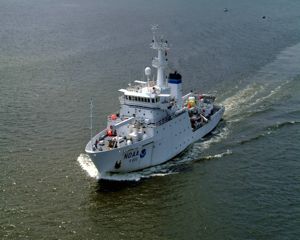Slick Technology
Air Date: Week of June 4, 2010

The Thomas Jefferson, a NOAA research vessel. (Photo: NOAA)
The National Oceanic and Atmospheric Administration's ship, the Thomas Jefferson, recently left on a nine-day mission to study subsurface oil in the Gulf of Mexico. Host Jeff Young talks with the ship’s commanding officer Shepard Smith about the high-tech advanced gear that the boat is outfitted with in order to track oil plumes on the move.
Transcript
YOUNG: From the Jennifer and Ted Stanley Studios in Somerville, Massachusetts - this is Living on Earth. I’m Jeff Young. The oil washing ashore and moving in sheens in the Gulf is a sickening sight. But it’s only part of the picture. Underwater plumes of oil have been detected, some of them tens of miles long and thousands of feet down. But there is little information on that oil’s chemical makeup, how it’s behaving and how it might affect marine life.
One of NOAA’s top research vessels, the Thomas Jefferson, is on a nine-day mission to help answer some of those questions. We talked with Commander Shep Smith just after the Thomas Jefferson set sail from New Orleans. Smith says the Thomas Jefferson has been equipped to seek out underwater oil.
SMITH: We have deployed a crude oil sensor on what’s called a moving vessel profiler. This is a really clever device that we deploy off the stern of the ship that can take a cast while we’re under way.
So, normally, in order to get physical properties of the water column you would have to stop the ship and lower an instrument down through the water column taking measurements with onboard sensors. This device will allow us to essentially free-fall those same sensors through the water column without stopping the ship, which will allow us to cover a much greater area in the same amount of time.
YOUNG: It sounds to me like you’re actually going to be able to, sort of, track these plumes- not just stopping and dropping place to place, but following it where it goes.

The Thomas Jefferson, a NOAA research vessel. (Photo: NOAA)
SMITH: Clearly, if there is a submerged plume it’s not a stable feature and we would want to continue to monitor and measure the progress of it and the size of it over time.
You know, where we have the highest confidence in a water sample with laboratory analysis, to say that what we’re observing truly is oil and it’s related to the spill, but on the other side we can cover much greater territory with much higher resolution with the sonar systems and the moving vessel profiler.
YOUNG: I mean, it sounds very exciting, it’s like sea hunt for oil, but on the other hand, it’s gotta be a little depressing, knowing that what you’re measuring is signs of possibly great damage to a great resource in the Gulf of Mexico.
SMITH: Well, I think you put it very well, and it’s very sobering. This is actually our second trip out here. When we passed by the spill site on our way in to New Orleans last week we were excited, as you said, getting all this gear ready, we were finally getting to the spill site and when we finally got there it got very quiet and everybody was really quite sober about what we were seeing.
YOUNG: Commander Shep Smith aboard the NOAA research ship, the Thomas Jefferson. Well, so far, three independent research teams have reported finding oil travelling in underwater plumes. Louisiana State University oceanography Professor James Cowan led one of those teams. The LSU’s submersible robot found oil deep off the Louisiana Coast.
Links
Living on Earth wants to hear from you!
Living on Earth
62 Calef Highway, Suite 212
Lee, NH 03861
Telephone: 617-287-4121
E-mail: comments@loe.org
Newsletter [Click here]
Donate to Living on Earth!
Living on Earth is an independent media program and relies entirely on contributions from listeners and institutions supporting public service. Please donate now to preserve an independent environmental voice.
NewsletterLiving on Earth offers a weekly delivery of the show's rundown to your mailbox. Sign up for our newsletter today!
 Sailors For The Sea: Be the change you want to sea.
Sailors For The Sea: Be the change you want to sea.
 The Grantham Foundation for the Protection of the Environment: Committed to protecting and improving the health of the global environment.
The Grantham Foundation for the Protection of the Environment: Committed to protecting and improving the health of the global environment.
 Contribute to Living on Earth and receive, as our gift to you, an archival print of one of Mark Seth Lender's extraordinary wildlife photographs. Follow the link to see Mark's current collection of photographs.
Contribute to Living on Earth and receive, as our gift to you, an archival print of one of Mark Seth Lender's extraordinary wildlife photographs. Follow the link to see Mark's current collection of photographs.
 Buy a signed copy of Mark Seth Lender's book Smeagull the Seagull & support Living on Earth
Buy a signed copy of Mark Seth Lender's book Smeagull the Seagull & support Living on Earth

